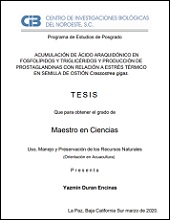Mostrar el registro sencillo del ítem
ACUMULACIÓN DE ÁCIDO ARAQUIDÓNICO EN FOSFOLÍPIDOS Y TRIGLICÉRIDOS Y PRODUCCIÓN DE PROSTAGLANDINAS CON RELACIÓN A ESTRÉS TÉRMICO EN SEMILLA DE OSTIÓN Crassostrea gigas
| dc.contributor.advisor | Palacios Mechetnov, Elena | |
| dc.contributor.author | Duran Encinas, Yazmin | |
| dc.date.issued | 2020-03 | |
| dc.identifier.uri | http://dspace.cibnor.mx:8080/handle/123456789/3038 | |
| dc.description.abstract | "Crassostrea gigas es un invertebrado marino que habita en la zona intermareal y, por lo tanto, está expuesto comúnmente a múltiples estresores ambientales, entre ellos la temperatura. En años recientes, se han reportado en México eventos de mortalidad masiva en C. gigas ligadas con el incremento en la temperatura durante el verano. En organismo sometidos a estrés térmico hay un incremento en la producción prostaglandinas (PG) por vía de la enzima ciclooxigenasa (COX) a partir del ácido araquidónico (ARA) presente en los fosfolípidos (FL) de la membrana celular, pero también de forma no enzimática por el incremento de especies reactivas de oxígeno (ROS) al incrementar el metabolismo. Se ha observado que algunos organismos sometidos a estrés acumulan más ARA en los triglicéridos (TG) y se ha propuesto que esto pudiera ser un mecanismo para evitar la producción no regulada de PG. El objetivo del presente estudio es evaluar si el ARA de la dieta se acumula en TG o FL y si un estrés térmico promueve la transferencia de ARA de TG a FL para producir PG usando isótopos estables en ostión C. gigas. Para probar nuestra hipótesis, semillas de ostión C. gigas fueron aclimatadas a 20°C y alimentadas con microalga Chaetoceros calcitrans marcada con 13C. Las semillas de ostión fueron sometidas a un estrés térmico cíclico con un incremento de temperatura de 15ºC diarios (de 20 a 35ºC) y luego una disminución, por un periodo de 4 días. Un grupo de semillas de ostión se mantuvo a 20ºC como control. Al final del experimento se tomaron muestras para análisis de ácidos grasos, isótopos estables, PG, expresión de HSP70, enzimas antioxidantes (SOD, GST, COI y GS) e histología. Las semillas sometidas a estrés térmico presentaron una disminución de la altura del epitelio de los túbulos digestivos y mayor número de hemocitos en el tejido conectivo, mayor concentración de PGEM y niveles de expresión significativamente más alto en todos los genes evaluados en este trabajo. El ARA en TG disminuyó su concentración en comparación con el control, mientras que en los FL no hubo diferencias significativas en la concentración. Se observó un ii incremento, aunque no llego a ser significativo, de la proporción de ARA en los organismos estresados..." | es |
| dc.format | es | |
| dc.language.iso | spa | es |
| dc.publisher | Centro de Investigaciones Biológicas del Noroeste, S.C. | es |
| dc.rights | Acceso abierto | es |
| dc.subject | ácido araquidónico, estrés, fosfolípido, isótopo, molusco, temperatura, triglicérido, prostaglandina | es |
| dc.subject | Arachidonic acid, stress, phospholipid, isotope, mollusk, temperature, triglyceride, prostaglandin | es |
| dc.subject.classification | FISIOLOGÍA ANIMAL | es |
| dc.title | ACUMULACIÓN DE ÁCIDO ARAQUIDÓNICO EN FOSFOLÍPIDOS Y TRIGLICÉRIDOS Y PRODUCCIÓN DE PROSTAGLANDINAS CON RELACIÓN A ESTRÉS TÉRMICO EN SEMILLA DE OSTIÓN Crassostrea gigas | es |
| dc.type | masterThesis | es |
| dc.dirtesis.grado | Maestría en Ciencias en el Uso, Manejo y Preservación de los Recursos Naturales | es |
| dc.dirtesis.disciplina | Acuicultura | es |
| dc.dirtesis.universidad | Centro de Investigaciones Biológicas del Noroeste, S.C. | es |
| dc.dirtesis.facultad | Posgrado en Recursos Naturales | es |
| dc.description.abstracten | "Crassostrea gigas is a marine invertebrate that inhabits the intertidal zone and therefore, is commonly exposed to multiple environmental stressors, including temperature. In recent years mass mortality events have been reported in Mexico in C. gigas associated with the increase in temperature during the summer. Organisms under thermal stress present an increase in prostaglandins (PG) production by cyclooxygenases (COX), an enzymatic route using arachidonic acid (ARA) present in the phospholipids (FL) of the cell membrane as substrate, but PG can also increase non-enzymatically by reactive oxygen species (ROS) that are produced during increased metabolism. It has been reported that some organisms exposed to stress accumulate a higher concentration of ARA in triglycerides (TG) and concluded that this could be a mechanism to avoid the unregulated production of PG. The aim of the present study is to evaluate if ARA from diet accumulates in TG or FL and if a thermal stress promotes the transfer of ARA from TG to FL to increase PG production in oyster C. gigas. To demonstrate our hypothesis, oyster seeds C. gigas were acclimated at 20°C and fed with Chaetoceros calcitrans microalgae labeled with 13C. Oyster seeds were subjected to cyclic thermal stress with a temperature increase of 15ºC daily (from 20 to 35ºC) and subsequently a gradual decrease to 20°C, for 4 days. Oyster seed kept at 20°C was used as control. At the end of the experiment, samples were taken for analysis of fatty acids, stable isotopes, PG, gene expression (heat shock proteins (HSP70), antioxidant enzymes (SOD and GST) and stress proteins (IOC and GS), and histology. The oyster seeds exposed to thermal stress showed a decrease in the height of the epithelium of the digestive tubules, as well as a greater hemocyte count in the connective tissue using histology, higher levels of PGEM and an increase in expression levels in all the different genes evaluated in this work. ARA concentration in TG decreased compared to the control group, while in FL there were no significant differences. A non-significant increase in ARA proportion in stressed organisms with respect to the control group was observed..." | es |
Ficheros en el ítem
Este ítem aparece en la(s) siguiente(s) colección(ones)
-
Tesis de maestría
Contiene texto completo de las tesis de Maestría de otras instituciones relacionadas con el CIBNOR

